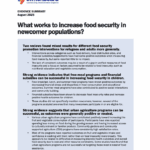Temporary foreign farm workers (TFWs) are among the most vulnerable and exploitable groups. Recent research shows alarming rates of food insecurity among them. This review explores research focussing on food security of TFWs in Canada and the United States, summarizes findings, and identifies research gaps. Online databases, including MEDLINE, Web of Science, Scopus, Google Scholar, and government and nongovernment websites, and websites of migrant worker–supporting organizations were searched for peer-reviewed and non–peer-reviewed papers and reports published between 1966 and 2020 regarding food security of TFWs. Articles reviewed were analyzed to determine publication type, country, year, target population, and main findings. Content analysis was performed to identify major themes. Of 291 sources identified, 11 met the inclusion criteria. Most articles (n = 10) were based on studies conducted in the United States. The prevalence of food insecurity among TFWs ranged between 28% and 87%. From the content analysis, we formulated 9 themes, representing a diversity of perspectives, including access to resources, income, housing and related facilities, food access, dietary pattern and healthy food choices, and migrant’s legal status. Instruments reported for the measurement of food security include USDA Household Food Security Survey Module (HFSSM; n = 8, 72.7%), the modified version of the USDA HFSSM (n = 1, 9%), hunger measure (n = 1, 9%), the modified CDC’s NHANES (n = 1, 9%), and 24-h recall, diet history, and/or food-frequency questionnaire (n = 3, 27.3%). Factors impacting food security of TFWs working under the Seasonal Agricultural Worker Programs (SAWPs) in North America are understudied. There is a need to advance research looking particularly at policies and regulatory and administrative aspects of the SAWPs to improve the food security of this cohort. There is also a need for qualitative studies that explore lived experiences and perspectives of TFWs and key informants. Longitudinal studies may be useful to examine various factors, including policy-related, contributing to food insecurity of TFWs over time.
The management of volunteers – What can human resources do? A review and research agenda
There is an increasing interest from scholars and practitioners in understanding how non-profit organizations can design and implement human resources (HR) practices to enhance desirable volunteer attitudes and behaviors. This paper presents a comprehensive overview of existing studies on the relationship between HR practices and volunteering outcomes. We use the ability-motivation-opportunity model as a guiding…

